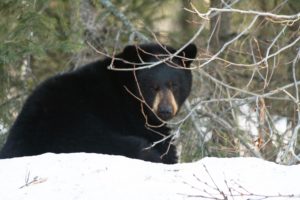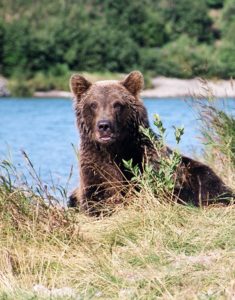Bears of Spring
At long last, breakup boots and sunglasses have replaced snowpacks and mittens. Bears are shaking off their long winter’s nap and they’re hungry. Last week, a friend and I had the privilege of seeing a black bear walk on top of hardened snow looking for springtime vittles.
Bears are fascinating on so many levels. They symbolize all that is raw and wild and beautiful about Alaska. And they are a testament that wild places still do exist.
Of course there were some decidedly mixed feelings when a bear’s habitat intersects with your own. Last fall, a trio of brown bears loitered around our neighborhood and created quite a stir. On more than one occasion, sightings of this sow and her two nearly-grown cubs caused the principal at Birchwood Elementary to cancel recess and keep the kids indoors. Around that same time Kristie Kuhl, an intern at Our Redeemer Lutheran Church, looked out her office window to see all three of the bears frolicking in the snow.
My horses let me know we had visitors early one morning when I went outside to feed. They snorted and huffed, looking pointedly at something in the dark. Moose often amble through the area, but this time the horses’ agitation was decidedly more animated. I stood and watched but beyond the circle of the barn’s light, the shadows fell deep. Whatever had trespassed was gone. A day later, my neighbor called to say one of the brown bears was in my yard, heading toward her place. The bears padded between her house and barn before making their way toward the nearby woods.
 We were all relieved when this bruin family finally decided to go to sleep for the winter. Now we are all wondering if they’ll be back. The sow may have new cubs, which means she would put last year’s teenagers out to fend for themselves. Fish and Game officials are once again entreating residents to keep food sources locked up so that bears have no reason to stick around. We’re a little nervous that they might take a liking to horse meat, but Jesse Coltrane of Alaska Department of Fish and Game says that she’s unaware of any horses being bothered by bears over the years. However, she fully expects these bears will get into trouble if they decide to stick around the Birchwood area.
We were all relieved when this bruin family finally decided to go to sleep for the winter. Now we are all wondering if they’ll be back. The sow may have new cubs, which means she would put last year’s teenagers out to fend for themselves. Fish and Game officials are once again entreating residents to keep food sources locked up so that bears have no reason to stick around. We’re a little nervous that they might take a liking to horse meat, but Jesse Coltrane of Alaska Department of Fish and Game says that she’s unaware of any horses being bothered by bears over the years. However, she fully expects these bears will get into trouble if they decide to stick around the Birchwood area.
Later on the same day that my friend and I saw the black bear, we also met a brown bear in captivity at the Alaska Wildlife Conservation Center in Portage. Our visit happened to coincide with the recent news that one of the Center’s brown bears had escaped its enclosure. Dr. Jordan Schaul, curator and conservation biologist for AWCC, had raised the runaway since she was a nine-month-old orphaned cub. Originally from Kodiak, Shaguyik had grown to 300 pounds and was two years old when she decided to emancipate herself. The remaining bear, Takquoka, was a little lonely without his partner. He ambled up to Schaul when he called and it was apparent that the handler and bear had a connection. Shaguyik and Takquoka were slated to move to a large bear facility in Sweden in June. It appears now that only one of them will make the trip.
Gauging by the popularity of bear-viewing in Alaska, the fascination with bears seems to be  universal. Of the top ten things I’ve done in Alaska, a visit to the McNeil River bear sanctuary would rank near the top of the list. It is hard to describe sitting on the gravel beach just a few yards from a brown bear as she teaches her cubs to strip the skin off a salmon before eating the roe. Or watching teenage bears spar and romp and grapple with the finer points of fishing. We humans were no more interesting to McNeil River bears than the squawking seagulls who also shared the beach.
universal. Of the top ten things I’ve done in Alaska, a visit to the McNeil River bear sanctuary would rank near the top of the list. It is hard to describe sitting on the gravel beach just a few yards from a brown bear as she teaches her cubs to strip the skin off a salmon before eating the roe. Or watching teenage bears spar and romp and grapple with the finer points of fishing. We humans were no more interesting to McNeil River bears than the squawking seagulls who also shared the beach.
All of which is to say, its springtime in Alaska. The sun lingers long and languid in a dome of blue. The bears are out. And the promise of summer shines abundant.